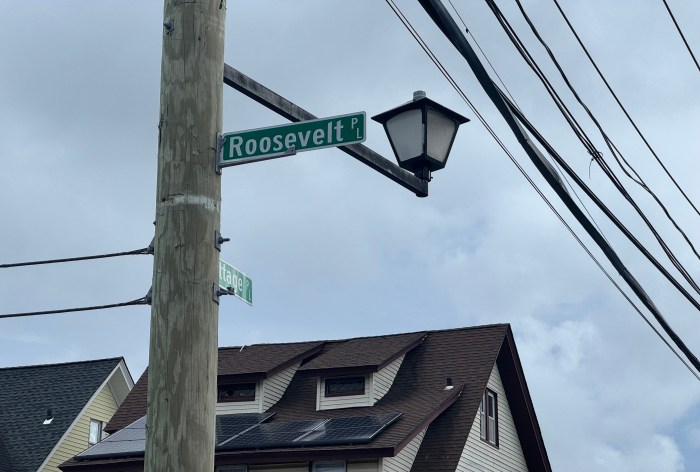On the heels of the Long Island Rail Road’s release of the final scoping document on plans to eliminate seven grade crossings in the first phase of its proposed construction of a third track along the railroad’s main line from Floral Park to Hicksville, local officials representing municipalities affected by the expansion expressed concern that essential details on the $1.5 billion project remain unknown.
“There are very few details and certainly there are no plans. The narrative is done in such a way as to make it seem not that significant,” said Floral Park Mayor Thomas Tweedy, a leader of the eight-member Mainline Mayors coalition who said the LIRR is taking a “build then design” approach. “They’re moving at an irresponsible speed.”
The MTA projects a three-year time frame for the construction, that it hopes to begin in 2017.
The final scoping document released at the end of August goes into some detail about information to be covered in the Draft Environmental Impact Statement (DEIS) expected to be released by the LIRR this fall. The 136-page document states that in contrast to the third track project proposed—and ultimately discarded on environmental grounds— in 2005, the current LIRR Expansion Project as it is officially known, won’t require a “substantial number of property acquisitions at grade crossings” or disrupt local communities during “extended construction periods.”
Dave Kapell, executive director of the Right Track for Long Island Coalition, comprised of more than 500,000 Long Islanders who support the expansion, expressed praise for the scoping document.
“This plan is a true departure from third track plans of the past,” said Kapell. “For a project of this magnitude to require zero residential acquisitions is a testament to the extraordinary effort by the governor and the MTA to do this the right way and with community support. The governor has kept his promise to keep homeowners in their homes, and there is no doubt that this third track will benefit our region, our economy and our families for generations to come.”
Village of Westbury Mayor Peter Cavallaro said while the final scoping document was important, he wasn’t expecting it to hold a lot of answers. He said the more telling document will be the DEIS.
“The DEIS will detail exactly what they’re planning on doing and address the various issues people have raised,” Cavallaro said. “That’s where the guts of the project will be laid out.”
Local officials uniformly expressed skepticism at the LIRR’s estimate that construction work on each of the seven grade crossings over the 9.8-mile corridor between Floral Park and Hicksville would require six to nine months.
“In our experience with grade crossing projects, that looks like a very optimistic time estimate to me,” said Assemblyman Ed Ra.
Mineola Mayor Scott Strauss reiterated his doubts on the project’s value to his community.
“What is the benefit of the third track to the residents of Mineola?” Strauss said.
He said LIRR officials recently assured him that third track construction would be within the existing LIRR right of way and no residential properties in Mineola would be taken in the process.
Ra said residential homeowners adjacent to the LIRR main line would endure negative consequences.
“When all is said and done, they may have people who will wish they had taken their property. It will certainly have an impact on property values and enjoyment of their property,” Ra said.
Ra also questioned the report’s assertion that funds for the project would not come from the Metropolitan Transportation Authority (MTA)’s capital fund program.
“We have not allocated state funds for this yet. I’m certainly not in favor of allocating state funds at this point,” Ra said, adding that no other state legislators representing the affected communities favor committing state funds for it.
The state funding assertion was the LIRR’s response to residents’ questions about the third track project in hearings held in June. The themed summaries included residents’ questions about the project’s ultimate effect on overall LIRR operations and impact on residential properties near the main line.
The LIRR’s responses cited increased flexibility of railroad operations as the project’s intended goal and said the DEIS study would delineate the impact on residential properties. It reports that noise monitors are to be installed soon to monitor decibel levels and project the impact of 25 trains moving along the third track daily by 2020.
The document also includes artists’ renderings of the LIRR’s alternative plans to eliminate seven grade crossings that were in the initial scoping document released in May, along with additional details on alternative plans to revamp the grade crossings and illustrations.
The grade crossings include those at Willis Avenue and Main Street in Mineola.
The absence of third track plans from the LIRR’s final scoping document are a major sticking point for local officials.
“We don’t have any idea for any plan for the construction. There is no design, no plans for this billion-dollar project,” said Garden City Mayor Nicholas Episcopia. “We have no idea where the staging areas for the equipment will be.”
Tweedy and Episcopia both said the LIRR needs to upgrade its outdated signal system to address existing rail service problems.
“The major problem is the switches and they have no plan that they’re willing to tell us about,” said Episcopia, who noted that $500 million has been earmarked for that purpose.
The final scoping document is accessible online at www.aModernLI.com, the MTA’s project web site.

































